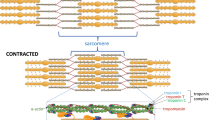Summary
-
1.
Force and ATPase activity were measured in skinned, fast muscle fibres isolated from the myotomes of Antarctic, temperate and tropical fish.
-
2.
Maximum isometric tension was inversely related to normal environmental temperature, when measured at −5 to 0°C. When compared within the normal temperature range of each species, tensions were rather similar.
-
3.
In contrast, the muscle fibres of all three species had similar cross bridge cycle times over the entire temperature range studied. This results in a more economical maintenance of force at normal body temperatures in muscle fibres from the Antarctic fish.
Similar content being viewed by others
References
Altringham JD, Johnston IA (1985) Adenosine triphosphatase measurements in skinned muscle fibres using high performance liquid chromatography. J Physiol 367:6P
Altringham JD, Johnston IA (1986) The energy cost of contraction in fast and slow skinned muscle fibres isolated from an elasmobranch and an Antarctic teleost fish. J Exp Biol 121:239–250
Connell JJ (1960) Studies on the proteins of fish skeletal muscle. 7. Denaturation and aggregation of cod myosin. Biochem J 75:530–538
Connell JJ (1961) The relative stabilities of skeletal muscle myosins of some animals. Biochem J 80:503–509
Ferenczi MA, Homsher E, Simmons RM, Trenthan DR (1978) Reaction mechanism of the magnesium ion-dependent adenosine triphosphatase of frog muscle myosin and subfragment-1. Biochem J 171:165–175
Johnston IA, Altringham JD (1985) Evolutionary adaptation of muscle power output to enviromental temperature: force-velocity characteristics of skinned fibres isolated from Antarctic, temperate and tropical marine fish. Pflügers Arch 405:136–140
Johnston IA, Brill R (1984) Thermal dependence of contractile properties of single skinned muscle fibres isolated from Antarctic and various Pacific marine fishes. J Comp Physiol B 155:63–70
Johnston IA, Mutungi G (1985) Effects of pH and temperature on the contractile properties of skeletal muscle fibres isolated from the iliofibularis muscle of the freshwater turtle,Pseudemys scripta elegans. J Physiol 367:79P
Johnston IA, Walesby NJ (1977) Molecular mechanisms of temperature adaptation in fish myofibrillar adenosine triphosphatases. J Comp Physiol 119:195–206
Johnston IA, Walesby NJ, Davison W, Goldspink G (1975) Temperature adaptation in myosin of Antarctic fish. Nature 254:74–75
Shriver JW (1984) Energy transduction in myosin. Trends Biochem Sci 9:322–327
Somero GN, DeVries AL (1967) Temperature tolerance of some Antarctic fishes. Science 156:257–258
Author information
Authors and Affiliations
Rights and permissions
About this article
Cite this article
Altringham, J.D., Johnston, I.A. Evolutionary adaptation to temperature in fish muscle cross bridge mechanisms: tension and ATP turnover. J Comp Physiol B 156, 819–821 (1986). https://doi.org/10.1007/BF00694256
Accepted:
Issue Date:
DOI: https://doi.org/10.1007/BF00694256




